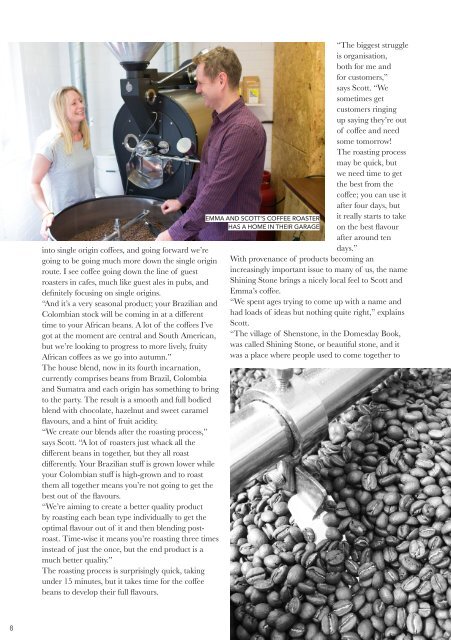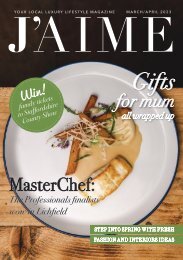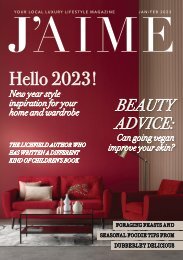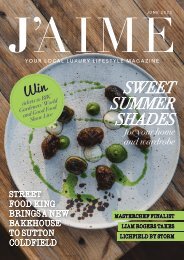You also want an ePaper? Increase the reach of your titles
YUMPU automatically turns print PDFs into web optimized ePapers that Google loves.
into single origin coffees, and going forward we’re<br />
going to be going much more down the single origin<br />
route. I see coffee going down the line of guest<br />
roasters in cafes, much like guest ales in pubs, and<br />
definitely focusing on single origins.<br />
“And it’s a very seasonal product; your Brazilian and<br />
Colombian stock will be coming in at a different<br />
time to your African beans. A lot of the coffees I’ve<br />
got at the moment are central and South American,<br />
but we’re looking to progress to more lively, fruity<br />
African coffees as we go into autumn.”<br />
The house blend, now in its fourth incarnation,<br />
currently comprises beans from Brazil, Colombia<br />
and Sumatra and each origin has something to bring<br />
to the party. The result is a smooth and full bodied<br />
blend with chocolate, hazelnut and sweet caramel<br />
flavours, and a hint of fruit acidity.<br />
“We create our blends after the roasting process,”<br />
says Scott. “A lot of roasters just whack all the<br />
different beans in together, but they all roast<br />
differently. Your Brazilian stuff is grown lower while<br />
your Colombian stuff is high-grown and to roast<br />
them all together means you’re not going to get the<br />
best out of the flavours.<br />
“We’re aiming to create a better quality product<br />
by roasting each bean type individually to get the<br />
optimal flavour out of it and then blending postroast.<br />
Time-wise it means you’re roasting three times<br />
instead of just the once, but the end product is a<br />
much better quality.”<br />
The roasting process is surprisingly quick, taking<br />
under 15 minutes, but it takes time for the coffee<br />
beans to develop their full flavours.<br />
“The biggest struggle<br />
is organisation,<br />
both for me and<br />
for customers,”<br />
says Scott. “We<br />
sometimes get<br />
customers ringing<br />
up saying they’re out<br />
of coffee and need<br />
some tomorrow!<br />
The roasting process<br />
may be quick, but<br />
we need time to get<br />
the best from the<br />
coffee; you can use it<br />
after four days, but<br />
it really starts to take<br />
on the best flavour<br />
after around ten<br />
days.”<br />
With provenance of products becoming an<br />
increasingly important issue to many of us, the name<br />
Shining Stone brings a nicely local feel to Scott and<br />
Emma’s coffee.<br />
“We spent ages trying to come up with a name and<br />
had loads of ideas but nothing quite right,” explains<br />
Scott.<br />
“The village of Shenstone, in the Domesday Book,<br />
was called Shining Stone, or beautiful stone, and it<br />
was a place where people used to come together to<br />
EMMA AND SCOTT’S COFFEE ROASTER<br />
HAS A HOME IN THEIR GARAGE<br />
8

















